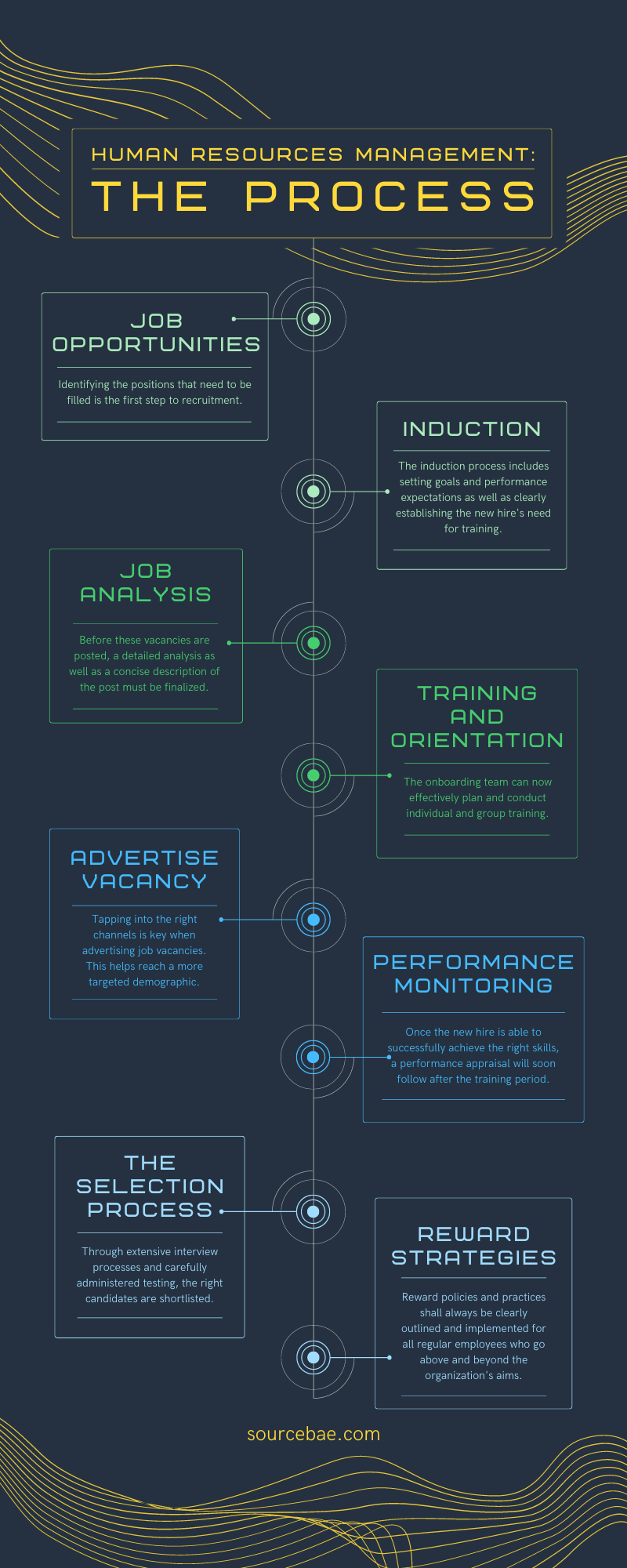In the dynamic landscape of modern business, Human Resources Management (HRM) stands as a vital pillar for organizational success.
Understanding the nuances of Human Resources Management: The Process is crucial for creating a motivated, productive, and engaged workforce.
In this comprehensive guide, we will delve deep into the various facets of HRM, shedding light on its pivotal role, strategies, and best practices.
Human Resources Management: The Process
Human Resources Management: The Process encompasses a series of well-coordinated steps that organizations take to manage their workforce efficiently. This process involves attracting, selecting, developing, motivating, and retaining employees while ensuring their well-being and optimal performance.

The Key Steps in HRM
- Recruitment and Selection: The first step in HRM involves identifying talent that aligns with the company’s values and objectives. Effective recruitment and selection processes are essential to secure skilled and dedicated employees.
- Onboarding and Orientation: Once new employees are selected, onboarding and orientation programs help them integrate smoothly into the company culture and familiarize them with their roles and responsibilities.
- Training and Development: Investing in continuous training and development is crucial to enhance employee skills and ensure they remain updated with industry trends.
- Performance Management: Evaluating employee performance regularly provides valuable insights into their strengths and areas needing improvement. Constructive feedback aids in professional growth.
- Compensation and Benefits: Fair compensation and attractive benefits packages motivate employees and enhance their job satisfaction.
- Employee Relations: Maintaining healthy employee relations fosters a positive work environment, resolving conflicts, and promoting collaboration.
- Health and Safety: Ensuring a safe and healthy work environment is not only a legal requirement but also showcases the organization’s commitment to employee well-being.
Strategies for Effective HRM
- Aligning HRM with Organizational Goals: HRM should be closely integrated with the company’s overall objectives to ensure that human resources strategies contribute to business success.
- Embracing Diversity and Inclusion: A diverse workforce brings a range of perspectives and ideas. Fostering an inclusive environment supports innovation and productivity.
- Talent Development Programs: Offering avenues for skill enhancement and career advancement encourages employees to stay committed and engaged.
- Effective Communication: Transparent communication between management and employees cultivates trust and maintains a harmonious workplace.
- Employee Recognition and Rewards: Recognizing and rewarding exceptional performance boosts morale and strengthens the employee-employer relationship.
- Succession Planning: Identifying and grooming internal talent for leadership positions ensures a seamless transition and reduces the impact of vacancies.
| Heading | LSI Keywords |
|---|---|
| Recruitment and Selection | Hiring process, candidate selection, job recruitment |
| Onboarding and Orientation | Employee integration, company culture, orientation program |
| Training and Development | Skill enhancement, continuous learning, professional growth |
| Performance Management | Employee evaluation, feedback process, performance appraisal |
| Compensation and Benefits | Salary structure, employee perks, benefit packages |
| Employee Relations | Conflict resolution, team collaboration, workplace harmony |
| Health and Safety | Occupational health, workplace wellness, safety protocols |
| Aligning HRM with Organizational Goals | HR strategy alignment, business objectives, strategic HRM |
| Embracing Diversity and Inclusion | Inclusive workplace, diversity management, diverse workforce |
| Talent Development Programs | Career advancement, skill development, training initiatives |
| Effective Communication | Transparent communication, open dialogue, management interaction |
| Employee Recognition and Rewards | Performance incentives, employee appreciation, rewards system |
| Succession Planning | Leadership pipeline, talent pipeline, internal promotions |
FAQs
How does effective HRM benefit a company?
Effective HRM enhances employee satisfaction, reduces turnover, fosters innovation, and aligns the workforce with the company’s goals, resulting in improved overall performance.
What is the significance of onboarding programs?
Onboarding programs facilitate new employees’ integration into the company culture, leading to quicker productivity and reduced turnover rates.
How can HRM contribute to diversity?
HRM can promote diversity by implementing unbiased recruitment processes, providing equal opportunities, and fostering an inclusive workplace culture.
Why is continuous training essential in HRM?
Continuous training keeps employees updated with industry trends, improves their skillsets, and contributes to their professional growth, benefitting both the employees and the organization.
How can companies ensure employee well-being?
Companies can prioritize employee well-being by adhering to health and safety regulations, promoting work-life balance, and offering wellness programs.
What role does communication play in HRM?
Effective communication between management and employees fosters trust, resolves issues promptly, and ensures a clear understanding of expectations and goals.
Conclusion
In the realm of modern business, Human Resources Management: The Process plays a pivotal role in nurturing a motivated and engaged workforce.
By strategically aligning HR practices with organizational goals, embracing diversity and inclusion, and fostering a culture of continuous learning and development, companies can create a workplace that thrives on collaboration, innovation, and success.
So, whether you’re an aspiring HR professional or a business leader aiming to optimize your company’s human resources strategies, mastering the art of HRM is undoubtedly a step toward achieving excellence.






